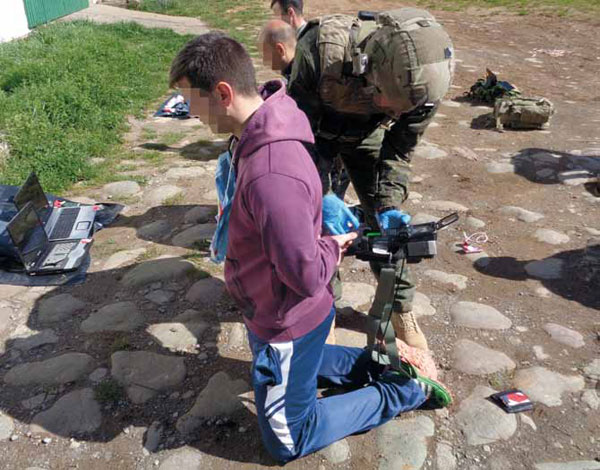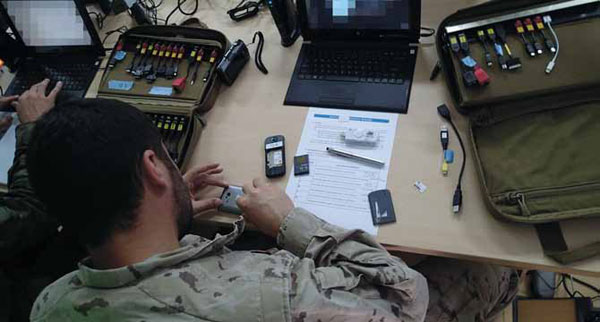- Home
- Feature Articles
- Lo que la misión esconde
What the mission hides
Friday, August 12, 2016
Number: 30
1st Teo Course (Technical Exploitation Operations) for Special Operations personnel
There are Special Operations Missions that imply much more than what they look on the surface. These missions are a source of information and evidence that must be collected (15 mins. max), guarded and analyzed. This is the reason that justifies the implementation of the 1st TEO course (Technical Exploitation Operations) that has already taken place in Spain at the Military School of Mountain and Special Operations (EMMOE in Spanish).
Earlier, the attendees took part in a distance learning phase to familiarize themselves with diverse NATO documentation related to this new ability.
According to the BOD (Official Defense Gazette of the Government of Spain): This new ability qualifies them as specialists in the field of technical exploitation at the tactical level of the Special Operations units. This gives them the technical know-how needed to plan and execute the searching, collecting, technical exploitation and guarding of the information and evidence obtained from a Special Operation, either national or multinational.
TEO is based on 3 pillars: biometric data, forensic techniques and DOMEX (Document and Media Exploitation). This last one is comprised of 3 other capabilities: DOCEX (gathering information from documents), CELLEX (cell phones exploitation) and MEDEX (gathering information from digital devices). These techniques are in the syllabus of the course.
The planning of TEO, the use of devices to get biometric data from an individual (iris recognition, fingerprints, photos, personal data…) and comparing data obtained with biometric databases real time were addressed in the course.
The course was also focused on: photography in all type of conditions; identification of chemical precursors (that can be used to make explosives); explosives detectors use; research on fingerprints (both, on a person under arrest and on objects of interest found); tactical interrogation; search of people, vehicules and facilities; legal considerations; and on how to get information from the inside of cell phones, PCs, and storage devices such as USB ports or hard drives.

ID verification on the biometric databases

In the classroom getting information from a cell phone

Fingerprints practice
The faculty had 3 permanent teachers – two from the NSHQ (one Spanish NCO and one USMC First Sargeant) and one Eurocorps NCO). All of them were accompanied by 5 guest speakers from the Civil Guard, the Joint Cyber Defense Command, the Joint Special Operations Command, the NSHQ, and the Counter-improvised explosive devices NATO Excellence Center (C-IED).
Regarding the students, 6 came from the Special Op. Command, 3 from Special Navy War Force (FGNE in Spanish), 3 from the Sappers Paratroopers Squadron (EZAPAC in Spanish) and 1 from the Military School of Mountain and Special Operations (EMMOE in Spanish). All of them with diplomas in Special Operations or serving in Special Op. Operational teams. English and IT knowledge was required.
In order to carry out this 1st course, the NATO Special Operation School (NSOS) was present in support with material and faculty members.
NCO Chahín, based at the NSHQ, led the course which content was almost identical to the course taught at the NSOS. Just one part was devoted to the Spanish laws regarding this type of activity.
The TEO course is prominently practical and the students put into practice what they have learnt in a very realistic atmosphere. All of them planned, managed and executed four subjects. Army and Air Force Special Operations components worked in the same team to bring to light what the mission hides.
ARMY UNITS
- Araba Álava |
- Albacete |
- Alicante |
- Almería |
- Asturias |
- Ávila |
- Badajoz |
- Barcelona |
- Burgos |
- Cáceres |
- Cádiz |
- Cantabria |
- Castellón |
- Ceuta |
- Ciudad Real |
- Córdoba |
- A Coruña |
- Cuenca |
- Girona |
- Granada |
- Guadalajara |
- Gipuzkoa |
- Huelva |
- Huesca |
- Islas Baleares |
- Jaén |
- León |
- Lleida |
- Lugo |
- Madrid |
- Málaga |
- Melilla |
- Murcia |
- Navarra |
- Ourense |
- Palencia |
- Las Palmas |
- Pontevedra |
- La Rioja |
- Salamanca |
- Segovia |
- Sevilla |
- Soria |
- Tarragona |
- Santa Cruz de Tenerife |
- Teruel |
- Toledo |
- Valencia |
- Valladolid |
- Bizkaia |
- Zamora |
- Zaragoza



